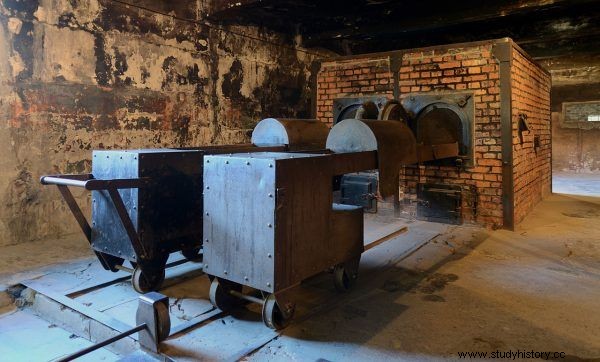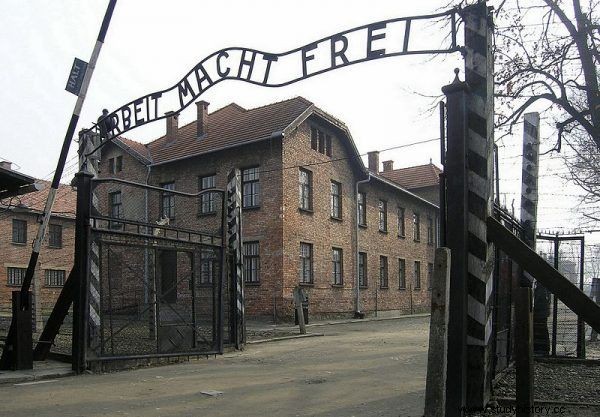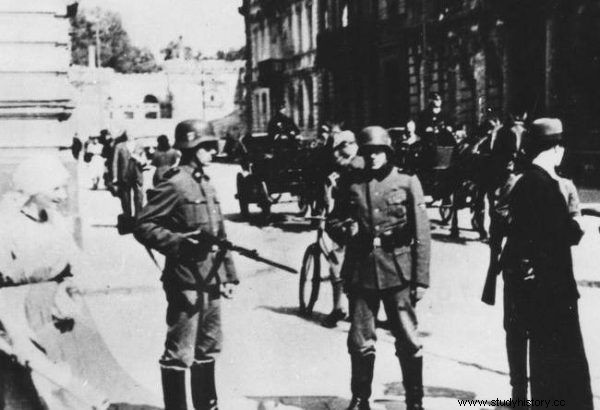Bartoszewski was a prisoner number 4427. He spent 199 days in the camp hell, after which he was released. For many people, the explanation comes to mind:he left because he collaborated. Was this really the case?
He was sent to Auschwitz on September 21, 1940, in the second transport from Warsaw. During the morning roll call, he and the rest of the new prisoners told the deputy camp commandant:
Look at the chimney over there. Look, this is a crematorium. You will all go to the crematorium. Three thousand degrees of heat. The chimney is the only way to freedom.
Bartoszewski, however, left the camp in Oświęcim through the gate, escorted by an SS man. It has spawned a lot of internet myths and plain lies. It's high time to expose them.
1. The only way out of Auschwitz was through the chimney
Presenting the case of Bartoszewski as completely extraordinary shows only a poor knowledge of the history of Auschwitz. During the existence of the camp, about 2,000 prisoners, including 1,600 Poles, were released. The vast majority of them were released in the first period of the camp's existence, until mid-1942.
In 1940, a total of 3,671 Varsovians were sent to the camp in Oświęcim, of which 331 were released. The transport, which brought Bartoszewski, numbered 1,705 people, of which no less than 149 were released, i.e. nearly 10 percent. Each of these prisoners was enormously lucky, but it was not a miracle requiring extraordinary explanation.

After being sent to Auschwitz, Władysław Bartoszewski heard that the only way to freedom was through the "chimney". However, this was not entirely true. About 2,000 prisoners were released from the camp, most of them by mid-1942. The photo shows the crematorium from the Auschwitz I camp (photo:Marcin Białek; license CC-BY-SA 3.0).
2. A dismissal is a reward for reporting
It might seem that the release had to be "earned", for example by informing or brutality in the role of prisoner functionaries. Nothing could be more wrong. It would even be contrary to the logic of the camp authorities' actions. Such "collaborators" could count on better treatment, but they were only useful in the camp.
In practice, the layoffs were largely accidental. This happiness was also enjoyed by the prisoners most admirable today. The best proof is the famous report by Witold Pilecki. The heroic captain informed that, among others, three people cooperating with him in the camp resistance movement were released from Auschwitz.
Among those released there were not only random people caught during round-ups, but also political prisoners brought from Pawiak. Many released from the camp hell later undertook cooperation with the Polish underground. An example is the aviation engineer Antoni Kocjan, who played a great role in the intelligence development of the construction of V-2 missiles
3. The reason for the dismissal was "poor health"
In 1940, Auschwitz was not yet a death camp, but already then prisoners were systematically devastated by, among others, hunger, physical abuse and slave labor. Diseases and exhaustion of the organism brought closer to the crematorium than to being released . No wonder that releasing anyone due to ill health is surprising. Only that nothing like that happened. It was exactly the opposite.
On December 12, completely exhausted and close to death, Bartoszewski fainted on the roll-call square. He ended up in the camp "hospital" (where treatment mainly consisted of lying down) and there he recovered for several months, regaining some strength.
On the day of his release, April 8, 1941, the future minister stood with several other prisoners before a medical commission. Polish medics powdered him with boils and ordered him to pretend to be fully healthy . For propaganda reasons, the sick were not released, the reason for being detained in the camp could even be too much
After successfully passing the inspection (because it is difficult to call it an examination), the prisoners signed a special statement in which they stated, among other things, that they had been treated well, had not been ill and had no complaints about anything. They were also forbidden to talk about the hangover and anti-state activities.

Ill health was definitely not a ticket to leaving Auschwitz. On the contrary. The photo shows the main gate of the camp with the famous inscription Arbeit macht frei (photo:Dnalor_01; license CC-BY-SA 3.0).
How often the mockery we meet about leaving Auschwitz on L4 is simply absurd.
4. "Prof. Mira Modelska-Creech… ”
The previous myths are primarily evidence of ignorance. The next ones are rather ordinary lies and nonsense. The Internet says this:Mira Modelska-Creech, prof. Georgetown University and the translator of the White House, tells the following story of an Auschwitz prisoner:
They came from the Bund, there were fourteen of them. They demanded a meeting with Frank. We, as prisoners, saw - Frank's convertible stood for two and a half days. [...] And then the old man knows that after Bartoszewski's departure, which happened by first-class train from Oświęcim, and the departure of those fourteen men, high-ranking Home Army soldiers were shot - twenty-one. The prisoner was convinced that Bartoszewski was a collaborator.
Were it not for the harmful popularity of these calumnies, it would be best not to mention them. The very origin of these revelations is bizarre. Modelska-Creech transferred them on the phone to Radio Maryja. She herself heard them from an unknown person, who in turn knew another anonymous man , allegedly imprisoned in Auschwitz at the same time as Bartoszewski. A real deaf phone.
Bundists (and therefore Jews) demanding in Auschwitz, meetings with Hans Frank could count not on an audience, but on a brutal beating and execution . Already in 1940, the release of Jews from concentration camps was forbidden, so they could not be released in 1941. Moreover, as confidants they would be practically useless for the Gestapo.

The history of the Warsaw underground is so well known that if Władysław Bartoszewski's actions actually led to the arrest of 21 prominent members of the underground, some trace of it would remain. And there is no such thing. The photo shows one of the streets of occupied Warsaw (source:public domain).
Additionally, it should be obvious to everyone that the prisoner in Auschwitz could not have known anything not only about Bartoszewski's spying activities in Warsaw, but also about the train on which he left Oświęcim. Moreover, Poles could only travel in passenger trains.
Let's ignore the obvious fact that in 1941 the Home Army did not yet exist . However, the history of the underground activity in Warsaw is quite well known. If the above story were true, it would be easy to identify the twenty-one high-ranking functionaries of the Polish underground who were shot as a result of Bartoszewski's denunciation. Nothing like this is possible though .
To sum up:lie on lie and a lie of a heathen.
5. Bartoszewski was an informer
It has already been mentioned that the camp informers were stopped behind the wires. It should also be added that Bartoszewski was sent to Auschwitz at the age of eighteen as an accidental victim of a round-up. He did not cooperate with the Polish underground yet . He was a nobody in the Auschwitz concentration camp and did not participate in the local resistance movement. He had no one to report on and there was no reason to be interested in him by the Gestapo.
And after dismissal? It is difficult to imagine that Bartoszewski, who was just starting his participation in the underground, could hand over twenty-one underground leaders to the Germans and, in addition, avoid being recognized as an agent. The future minister collaborated with the Home Army until the end of its existence and if he was an informer, he could denounce many more his companions. He did not do it. There is simply no evidence of his alleged collaboration.
6. Bartoszewski's sister married an SS man
Another slander circulating on the Internet concerns Władysław Bartoszewski's sister. She would collaborate with the Germans and marry an SS man, thanks to which she arranged for her brother's release from Auschwitz. This lie is downright absurd, the future minister was an only child .
Repeating this nonsense once again also testifies to a complete ignorance of the realities of the occupation . Ignorants should be reminded that the Third Reich was a racist state, and sexual contacts with Polish women (not counting prostitutes) meant disgrace to the race and threatened to be sent to a camp. The ban was not enforced with all force, but the marriage of an SS man with a Polish woman was simply impossible.

Even if Władysław Bartoszewski did have a sister, German law did not allow an SS man to marry a Polish woman. The photo shows the Gestapo headquarters in Warsaw on Aleja Szucha (source:public domain).
***
Władysław Bartoszewski was an employee of the Polish Red Cross before his imprisonment. His father tried to engage this organization to help and it was probably her intercession that decided to release the future minister. Some efforts were made by his mother, who bribed unknown intermediaries who promised to settle the matter. Support was also promised by the volksdeutsch worker working with her.
The Germans did not inform those released from the camp why they were released . Many lucky people never found out, and Bartoszewski was not sure either. The intercession of the management of the workplace, bribing the right person, and even a petition to Hans Frank or Adolf Hitler himself - these were all factors that allowed at least to initiate the appropriate procedure.
What was decisive in this particular case is unknown. Be that as it may, is not worth believing in vile lies.
